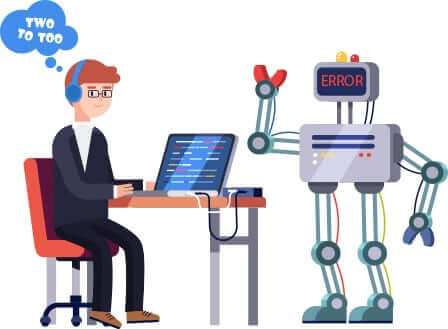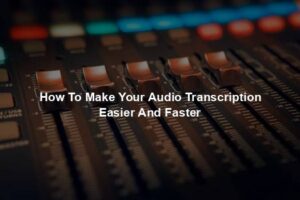
Why Use Human Transcription Services?
Just try popping a few names of country leaders, bands or albums into a Word document and running a spell checker and imagine what an automated dictation program would do with these terms! That is precisely why in this article, we will explore why you should use a human transcriber as opposed to speech recognition software, and how exactly you can get the best out of these human transcription services.
What Are The Benefits Of A Human Transcriber Over Automatic Speech Recognition (ASR) software?
I think you have an answer by now
1. Humans Can Handle Background Noise
- The greatest advantage human transcriptionists have over automated transcription software is their natural capability to filter through background noise. Obviously, presenting the clearest quality audio file is definitely the very best practice. However, humans can filter through background noise and still deliver an exact transcript. Automated transcription services have an arduous time handling background noise. This results in inaccurate transcripts or perhaps a complete rejection of the audio file. Any speech recognition and transcription software will need a clear piece of audio. For example, these scenarios may impair the ability of speech recognition software to work accurately:
- People talking while they’re eating and eating while they’re talking
- Interruptions from waiters/room service / other members of the band or group
- Overlapping speech
- Very technical content – jargon and acronyms galore
- Creative content – album names, track names, novel titles, band names, author names
2. Humans Can Easily Differentiate Between Homophones (To, Too, Two)
- One of many quickest ways to tell whether your transcript was done by a device is to look for errors in homophones. Homophones are two or more words that have exactly the same pronunciation but different meanings, origins, or spelling. Speech recognition software must count on sentence structure to predict probably the most probable word to use. This can often cause mistakes. As an example, let’s say that the doctor was frustrated and lost his patience with someone. A human transcriptionist would transcribe, “The physician lost his patience,” on the basis of the context. An automated transcriber would probably transcribe, “The physician lost his patients.”
3. Humans Can Understand Different Accents And Dialects
- Another obstacle for automated transcription software is accents and dialects. When you can find varying accents, or possibly a dialect the software cannot recognize speech recognition software struggles. Humans, however, are continually exposed to varying accents and dialects. This exposure paired with human transcriptionists’ natural capability to adapt give humans the bonus – irrespective of the speaker’s accent. Within an increasingly global marketplace.
4. Humans Are Capable Of Identifying Any Number Of Individual Speakers
- Automated transcription software typically cannot identify individual speakers and deliver accurate transcripts when there are many speakers present. This could prove very troublesome for anybody who needs to transcribe audio with 3+ speakers, like a business meeting. Humans, however, can understand and identify multiple speakers, even once the speakers sound alike. Not only will automated transcription software battle to identify multiple speakers in the first place, but in addition, they cannot accurately track those speakers through the audio.
How Can You Increase The Likelihood Of Getting A Good Transcript Prior To The Actual Transcription Process?
Even people who purchase and use transcripts on a regular basis sometimes have only a limited idea of how exactly transcripts are produced. You talk into a recorder, and someone hands you a script of it later, right? The mystery is understandable; how many of you really know the finer points of how your car works or your smartphone? We just need to know how to use them. But, just like those electronic devices, you can get a lot more out of your transcripts by understanding exactly what goes into them and what you can do to affect them. No, there isn’t a magic fix you can purchase for your transcripts, but actually in a way maybe there is. When ordering a transcript, it’s important to bear in mind the following:
1. Consider Your Audio Recording Technique
- What exactly are you giving your transcriptionist to work with? Is it a cassette from your personal recorder, or is it a professionally produced audio file? Where was the microphone? There are dozens of factors that can contribute to the quality of the audio recording, and the quality of the audio recording is absolutely essential when it comes to producing a readable transcript later. A lot of people rely on personal recorders or dictation devices to record their meetings or hearings. Some of these devices record onto cassette (either standard or micro) and some record digitally, but all of them come with some risk when relied upon for recording multiple speakers. These devices are primarily intended to record a single speaker holding the machine directly in front of their lips. Placing it on a table in the middle of a meeting is no guarantee that everyone will be picked up on the microphone. If this is the route you want to go, choose a device that boasts an omnidirectional microphone. For example, the Olympus LS-14 recorder has two 90-degree coverage microphones on it, which will easily cover a conference table, but is at least three times the cost of most consumer-level devices.
- (Oh, and be extra wary of microcassette recorders. The format is only made possible by using thinner audiotape and a slower recording speed than standard cassettes, making them much more susceptible to damage and degrading over time. If you do use a microcassette recorder, make a backup A.S.A.P.)
- If you have the budget, why not aim for a more professional recording? Multiple microphones (ideally one per speaker) with a mixer or a digital recorder with multiple inputs are now common. You have the option to adjust audio levels for each microphone separately, and you can even produce recordings where the transcriptionists can adjust these levels themselves during playback. If you are regularly producing recordings requiring transcription, a small investment in recording technology can pay you back handsomely with years of readable transcripts.
2. Be Mindful of Cross-talk and Talking Too Fast
- Are your participants aware that they are being recorded for later transcription? If not, they’re probably not speaking in the direction of the microphone(s); they’re probably talking over one another, and they’re almost certainly speaking too quickly. It’s a good idea to caution the speakers, before the recording begins, that they need to speak loudly and clearly, to mind the microphone(s), and to avoid stepping on each other’s sentences. If someone acts as a moderator during the recording to periodically remind speakers of these ground rules, your transcript will benefit from it.
3. Be Prepared for Speakers with Accents
- Special attention should be paid to any speakers with strong accents. Any reputable transcription company will do its best to pair your recording with a transcriptionist who has a good ear for that particular accent, but they need to be warned ahead of time. If halfway through a 2-hour meeting, there is a presentation given by a speaker from France, the unprepared transcriptionist may not have time to do anything more than giving it their best shot, which could result in the loss of a lot of that presentation. And remember that the more obscure and the accent is (relative to the audience), the more unlikely the transcriptionist will be able to parse it out. Urge all accented speakers to take a special effort to enunciate and make themselves understood.
4. Keep Background Noise to a Minimum
- Where is your recording taking place? Is it a hot day, so you have a window open, or worse, an air conditioner running? Those sounds will compete with your speakers’ voices for prominence in the recording, so make sure that the microphones are aimed as much as possible at the people you want to hear. If the door is open to a noisy hallway, or the window to lots of street noise, close it. Ideally, do a sample recording beforehand so you can hear how the background noise competes with the speech. And don’t forget that all electronic devices emit an electromagnetic field to some degree, just by virtue of being on, and this field can show up in your recording as a hum or a buzz, often quite loud. If you have a large electronic device in the room (like an industrial copy machine), it may need to be shut off.
5. Prepare the Transcriptionist for Unique Terminology
- When a transcriptionist comes across a word or phrase with which they’re unfamiliar, they’ll usually do their best to spell it phonetically. Unfortunately, this can leave the transcript looking amateurish at best (the name, “Andy Ziats” becomes “Andy Zayitts”), and misleading at worst (“SA program” becomes “essay program”), but a very easy fix is to prepare the transcriptionist beforehand with a list of keywords. This includes proper names (of both people and places), specialized terms (legal, pharmaceutical, etc.), and any acronyms to be used in the discussion. The list prepared beforehand is unlikely to be exhaustive, but it will go a long way towards reducing confusing or useless passages in your transcript.
6. Make Sure that All Speakers are Identifiable
- This one comes as quite a shock to many transcription clients: when a meeting is being held with four or more participants, it is rare that the speakers’ voices are distinct enough for a complete stranger to reliably identify them throughout the transcript, especially for short “yes/no” or “uh-huh” statements. As a result, your document may eventually degenerate into a series of questions and answers attributed to “Male Voice 1” through “Male Voice 4,” and, in cases of very similar voices, even the numbering may not be possible.
- Thankfully, this is another easy fix. If your schedule and budget allow, it’s a good idea to have someone sit in on the meeting solely to produce speaker ID notes. All that’s required is to number the participants, then keep a running list of the numbers in the order of which they speak, along with the first word or two of their statements. This is basic data entry and more advanced notes can be taken if time allows, but with just this bare minimum, you will see a dramatic increase in the accuracy of the IDs listed in your transcript.
7. Understand the Implications of Turnaround Time
- Finally, how quickly do you need your transcript? The average professional transcriptionist takes between 2.5 and 4 hours to transcribe a single hour of audio, so if you need your 8-hour meeting which ended at 8:00 P.M. transcribed by first thing tomorrow morning, there are not enough working hours left for a single person to do the job. The task will need to be split among multiple transcriptionists, who will then lose the benefit of context when it comes to naming spellings, proper terms, and even matching names to voices. A responsible transcription company will task an editor with combining the parts of the transcript and ensuring the pieces are as consistent as possible, but an editor’s practiced scan is still no substitute for the 8 hours of real-time attention that is most profitably done by a single individual. If accuracy is a higher priority than a turnaround, consider giving an extra day or two for transcription time. You’ll definitely notice the difference in the final product.
Are Human Transcription Services Too Expensive?
- Anyone looking to engage with transcription services for the first time will probably be struck by the vast differences in price. Some services look like free while others charge in excess of £2 per recorded minute of audio. Precisely what costs significantly more than £0.75 each and every minute of audio would have been a ‘human transcription service ”. The cheaper services are all delivered by Automatic Speech Recognition software. This leads many people to question if human transcription services are worth the cost.
- The answer to this question depends on your own audio quality and the last transcript that you need. While human services are going to cost more, this doesn’t necessarily cause them to become very costly or unaffordable. The extra costs of human transcription services pay for something. You are spending money on quality control and options around outcomes. If that is what you need, they aren’t very costly because automated transcription services do not deliver these outcomes.
1. Paying For Quality: The Power of Human Transcription Services
- While automated transcription services offer cheap pricing and quick turnarounds, they don’t offer quality control. You obtain everything you get, and if your audio is low quality or has many speakers, you could end up with a transcript that’s simply gibberish.
- You can find issues revolving around audio quality accents, speaking patterns, and colloquial language. If the software struggles to detect the audio or results in slang words that it can’t register, then your answers are incredibly inaccurate. Even under ideal circumstances, automated services struggle to hit accuracy rates above 80%.
- Human transcription services deliver results that you could rely on, that’s everything you are paying for. They have quality control mechanisms. If the audio is poor, transcribers can spend more time reviewing the content. A human can detect slang with relative ease, understand different accents, and handle poor audio quality with less difficulty.
- Fundamentally, there’s no place where machines can match the language processing power of the human brain. If you’d like your transcript done right, you will have to pay a person to do it. If you are using an automated service, expect to invest your own time reviewing and editing the transcript to have something that accurately reflects your recording. If your audio quality is poor, anticipate starting again from scratch if what’s delivered is unintelligible.
2. Paying For Variety: Human Transcription Services Offer More Variety
A top-quality human transcription service will even give you variety around the service. With human services, you can tailor what you to match your needs. Most human transcription services will allow you to completely customize formatting and transcription priorities.
- Word for Word transcripts provides the full details of what had been said. But, the standard word for word human transcriptions will tidy up the audio for you personally, removing ‘ums ‘, ‘errs’ and false starts. This is really more straightforward to transcribe, so you’ll often get an amount to break for this sort of transcript while receiving something that is more straightforward to read.
- Summary/Notes transcripts enable you to get an overview of a recording and digest the meaning without having to read each word. In addition, they tend to be much cheaper each minute. Nevertheless, you obviously don’t get each detail.
- Verbatim transcripts deliver detail. You get a phrase for word transcript that also incorporates any ‘ums’ and ‘ahs ‘, pauses, and so on. They can even include notes on tone and laughter.
Human transcription services can offer a lot more than automated versions. What this means is they feature far less expensive in as you are able to pay for exactly that which you need. Instead of paying the most effective price for a detailed verbatim transcript, you can pick a summary instead — if it satisfies your requirements. Below are some other illustrations.
- The majority of the journalists like with an indication of when their subject slowed down or had to mull over something and ask to add notes of those pauses.
- Business people producing podcasts and telecasts often want a reasonably accurate transcription, but smoothed out to eradicate ums, ahs, pauses, and repetitions, so they have an excellent product to market or include in packages because of their clients.
- Some international conferences want to avoid embarrassment because of their delegates by having their English rewritten as I transcribe to seem as clo0se as possible to native British (or American) English
- Authors who start off with tape and are interested to become something they are able to publish as a book (this, unlike every one of the other available choices, involves two processes: transcription and then heavy editing and rewriting).
3. Paying For Security: Data Protection & Security
- When you’re paying for a transcript, you must be certain that the data you pass across is completely safe and secure. Otherwise, there’s no telling who could obtain practical some important business information via your audio recordings or the completed transcripts.
- With both human and automated services, you need to consider the hallmarks of data security. Research where your computer data is stored, how it’s stored and how it’s shared. You would like SSL encryption. Always look for ‘https’ in the website URL as this ensures that the personal information is secure. Also, check for ISO 27001 & 9001 certifications as these indicate a secure data environment.
- Fundamentally, you need your computer data to stay within jurisdictions with high ethical business standards and judicial systems that pursue violations. Without that, it will be harder to follow along with up breaches, increasing the likelihood in which they occur.
- With automated transcription services, it could be difficult to ever get your computer data removed from servers. This advances the likelihood, so it eventually ends up in the incorrect hands. With human transcription services, data security is usually the difference between the lower and high-end fees. Human transcription services that cost less than £0.75 each and every minute of recorded audio in many cases are with a lack of a fundamental area — data security may be one of the first areas to go. If you want security guarantees, you may want to go through the higher end of the market.
Conclusion: Human Transcription Services Are Not Too Expensive if You Need Quality and Options
You Can Still Get A Good Deal On A Human Transcription Service
- Plenty of businesses are unaware of how many deals you can find in the human transcript world. While you’ll never get the same price as an automated option, you can still take measures to lower the expense to match your budget.
- For instance, you can choose longer turnaround times to acquire a cheaper rate. There is often a sizable price break if you’re willing to wait significantly for more than seven days. If the transcript isn’t a sudden priority, this can be a smart solution to squeeze out more value from the service. Likewise, the different transcript options mean you just pay for what you need.
- The bottom line is that you will find brilliant transcription services that also offer excellent affordability when you explore the different deals available. As a consequence, this will lower the expense without diminishing the service quality.
- By taking a look at the price tag on these services alone — particularly when comparing to an automated transcription service — it’s easy to believe they’re too expensive. But, the deeper you dig, the more you realize that human transcription services are incredibly affordable.
- Essentially, everything boils right down to the service quality. You receive more from your money whenever you spend extra on an individual service since it will always provide a higher degree of accuracy. Not just that human services can handle poor audio much easier. Humans can pause and decelerate audio tracks to understand fast talkers and listen through any additional background noise that could be disrupting the audio. What’s more, an individual transcription service handles accents and slang words way much better than automated ones.
- Human transcription services also enable you to tailor your transcript to your specific needs. When combined with additional data security measures, then the expense of human transcription services seems extremely reasonable indeed.
- When all’s said and done, human transcriptions are far more expensive — but they’re certainly not too expensive. Remember, you get what you pay for. So, if you like the very best service possible, then be prepared to spend money on it.







